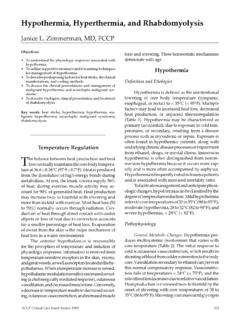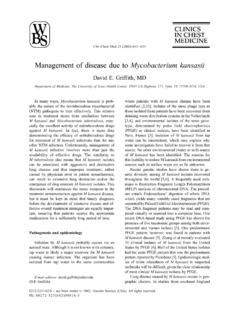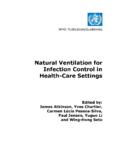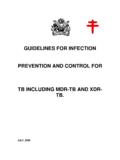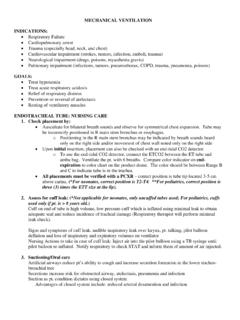Transcription of Management of agitation in the intensive care unit …
1 Management of agitation in the intensive care unitMark D. Siegel, MDa,b,*aPulmonary and Critical care Section, Yale University School of Medicine, Post Office Box 208057,New Haven, CT 06520-8057, USAbMedical intensive care Unit, Yale-New Haven Hospital, 20 York Street, New Haven, CT 06504, USAA gitation is a frequent, challenging problem inintensive care units (ICUs) and affects at least 71%of patients, both young and old[1 3]. Contributingfactors include underlying illness, pain, anxiety, anddelirium. Dangerous consequences range from poorlytolerated invasive therapy to self-destructive behavior,leading to widespread, sometimes heavy-handed, se-dation[4,5].Patients in the ICU are often too sedated. A recentstudy found that fewer than 5% were agitated whenassessed; this suggested that some sedation is exces-sive or unnecessary[6]. Used inappropriately, seda-tives can impair cognition and depress consciousnessand lead to secondary complications, such as failure towean from mechanical ventilation, prolonged ICUstays, and increased cost of care [7 10].
2 Conscien-tious clinicians must strike a balance between treatingagitation and avoiding oversedation. This article out-lines a systematic, practical approach to evaluatingagitation and suggests recommendations for safe,effective and causes of agitation in theintensive care unitAgitation is characterized by excess motor activityand is driven by internal factors, such as disease,pain, anxiety, and delirium[11,12]. Activity may bepurposeless or, more dangerously, include removing or disconnectingcatheters, self-extubation, ventilator dysynchrony,and increased oxygen consumption[13 18]. Agita-tion may also lead to detrimental long-term outcomesthat range from unpleasant memories to posttraumaticstress disorder, although some investigators have sug-gested an association with treatment, rather than agi-tation itself[19 24].It is tempting, but dangerous, to consider agitationthe natural consequence of critical illness.
3 Similarly, itwould be wrong to sedate patients indiscriminatelywithout considering causes that require specific treat-ment(Box 1) [1,25]. Many patients need sedation,particularly those who require mechanical ventilation,but inappropriate or excess sedation can have un-intended consequences[7,8]. In addition to increasedlength of stay and failure to wean from the ventilator,excessively sedated patients can develop prolongedcognitive impairment and delirium. Important prob-lems, such as chest pain, dyspnea, and neurologicchanges, can be missed because patients are difficultto patients need the same type of systematicevaluation applied to problems such as hypotensionand hypoxia. Finding a specific cause may allowdirected, effective treatment (seeBox 1). Potentiallylife-threatening problems such as hypoxia, hypercar-bia, hypoglycemia, and sepsis should be that can be easily corrected, but are oftenmissed because patients cannot communicate, shouldbe sought.
4 Examples include uncomfortable bed posi-tion and dry problem of patient-ventilator dysynchronymerits special attention[15 17]. Potential causes in-clude inadequate or excessive inspiratory flow rates,tidal volumes that are too high or too low, andineffective effort. Inadequate ventilator flow rates can0272-5231/03/$ see front matterD2003 Elsevier Inc. All rights (03)00104-7* Pulmonary and Critical care Section, Yale UniversitySchool of Medicine, Post Office Box 208057, New Haven,CT Chest Med 24 (2003) 713 725be readily detected by examining ventilator some patients, simple maneuvers, such as changingthe inspiratory flow rate or tidal volume or usingpressure control, may improve tolerance of mechanicalventilation. Occasionally, however, heavy sedationmay be required for poorly-tolerated mechanical ven-tilation techniques, such as inverse ration ventilationor permissive hypercapnia.
5 Still, medication shouldnever substitute for effective ventilator of agitationCompared with life-threatening problems, such asshock and respiratory failure, the treatment of agitationreceives little attention. A recent systematic reviewfound only 15 prospective, randomized studies thatinvestigated successful sedation as a primary outcomein mechanically-ventilated patients[26].Effectivemanagement, however, in addition to providing com-fort, is indispensable in helping patients tolerate some-times noxious treatments and of nonpharmacologic approachesand treatment of specific medical disorders alwaystakes precedence. Life-threatening problems, such ashypoxia and hypoglycemia, and pain from acute dis-eases, such as myocardial infarction, require promptattention. Non life-threatening problems, such asfear, inability to communicate, and uncomfortablebed position, may respond to simple interventions,such as reassurance, a writing board, and reposition-ing.
6 General approaches that may promote comfortinclude music therapy and hypnosis, although theeffectiveness of these interventions requires furtherstudy[27,28]. Even when medication is required,nonpharmacologic interventions can be usefuladjuncts to allow lower dosages of , anxiety, and delirium are the most commoncauses of agitation that require medication[1].Itiscritical to distinguish among them because eachrequires specific treatment with analgesics, anxio-lytics, or antipsychotics, alone or in failure to identify these problems, particularlypain and delirium, can result in missed opportunitiesfor effective treatment. Some patients become with-drawn rather than agitated but still need should be used judiciously and thought-fully and never as a nonspecific chemical restraint. Pharmacotherapy in the critically ill poses uniquechallenges, particularly because the most commonlyused agents have been studied primarily in otherpopulations, such as otherwise healthy people whoare undergoing surgery.
7 Findings from these studiesmay not extrapolate well to the ICU. Factors that mayalter response to sedatives and analgesics are outlinedinBox for pain, anxiety, and delirium are largelylipid soluble. Variations in lipid solubility determinemany pharmacokinetic properties. More highly solu-ble agents, such as fentanyl and midazolam, have amore rapid onset than less soluble ones, such asmorphine and lorazepam(Table 1). Similarly, after asingle dose, the effects of highly soluble medicationsdiminish more quickly with diffusion into adiposetissue. In contrast, when given repetitively or continu-Box 1. Causes of agitation that requirespecific interventionsPotentially life threateningGas exchangeHypoxemiaHypercarbiaMetabolicHyp oglycemiaAcidosisVentilator relatedEndotracheal tube malpositionTension pneumothoraxInfectionCentral nervous system infectionSepsisDrug and alcohol relatedIntoxicationWithdrawalIschemiaMyo cardialIntestinalCerebralMiscellaneousPa tient-ventilator dysynchronyInadequate flow ratesExcessive tidal volumesUncomfortable bed positionFearInability to communicateSleep deprivationFull bladderNauseaNeed to defecateNicotine withdrawalDrug side effectsAnticholinergicParadoxical responseto Siegel / Clin Chest Med 24 (2003) 713 725714ously, lipid stores build and the effects of otherwiseshort-acting drugs become prolonged and more de-pendent on liver and renal metabolism and given in combination (eg, benzodiazepines andnarcotics)
8 , many agents become synergistic and po-tentially increase efficacy but also ( Management of pain)There are few reliable estimates of the prevalenceof pain in patients in the ICU. Pain and discomfort arecommon, for example, in those with cancer[29].Itislikely, however, that pain is widely prevalent, given thenature of critical illness, treatments, and related pro-cedures. Unrelieved pain causes a variety of untowardresponses, including tachycardia, increased oxygenconsumption, hypercoagulability, immunosuppres-sion, and persistent catabolism[1].Pain is inherently subjective and therefore, detec-tion and assessment depend upon a patient s ability tocommunicate, the most reliable indicator being selfreport. Visual analog, numerical rating, or verbal ratingscales may help patients describe symptoms andseverity. For those who cannot communicate, recentlyintroduced techniques that focus on factors, such asphysiologic changes, movement, and facial expres-sions, may help clinicians assess pain.
9 Two recentlydescribed scales, the and BPS, are examples[30,31].Narcotics are the main agents used to treat pain;they work primarily by binding to specific receptors inthe central nervous system (CNS)[32]. At low doses,they provide analgesia. Sedation occurs as doses in-crease. Narcotics can be given by several routes:intravenous (IV), intramuscular, enteral, intrathecal,transcutaneous, inhaled, and epidural. IV is used mostcommonly in the ICU for predictable delivery. Unlikebenzodiazepines and propofol, narcotics provide noanxiolysis or amnesia. All are specifically antagonizedby narcotics that are recommended for the ICUare morphine, fentanyl, and hydromorphone[1]. Me-peridine should be avoided because active metabolitesthat can cause seizures may accumulate, particularly inrenal failure. Newer, rapidly-acting agents, such asalfentanil, sufentanil, and remifentanil, have no clearrole at present[33].
10 Morphine and meperidine are metabolized by theliver to active metabolites that depend on the kidneyfor excretion. Dosage adjustments are required withrenal dysfunction[34]. In contrast, fentanyl has no ac-tive metabolites and dosage modifications are proba-bly unnecessary. All narcotics require adjustment inthe elderly, those who have hepatic dysfunction, andwith previous effects include those that are characteristic tothe class and those that are related to specific narcotics cause respiratory depression, dysphoria,decreased gastrointestinal motility, nausea, and eme-sis, which can interfere with enteral feeding[35]. Allcan cause hypotension, particularly when patients arevolume-depleted. Hypotension is more common withmorphine than fentanyl, particularly when given as abolus[33]. Factors that contribute to hypotension ineuvolemic patients include sympatholysis, vagally-Box 2. Factors in the critically ill that alterresponse to sedative and analgesic agentsAdvanced ageMalnutritionDecreased protein bindingHigh total body waterIncreased volume of distributionDecreased fat and lean massAltered liver and renal functionSlowed metabolismObesityThe effects of underlying diseasePolypharmacyTable 1 Pharmacology of commonly used sedatives and analgesicsDrugInitial doseMaintenance dosagePeak (min)Duration after bolus (min)Fentanyl25 2mg/kg/h2 530 45 Morphine2 5 mg2 10 mg/h30120 2 mg/kg/h2 530 2 mg/kg/h15 30360 mg/kga5 75mg/kg/min< 1 +5 10 Haloperidol2 10 mgb25% of load q6 hrsb30 Variable (hours)aPropofol boluses commonly cause hypotension.
